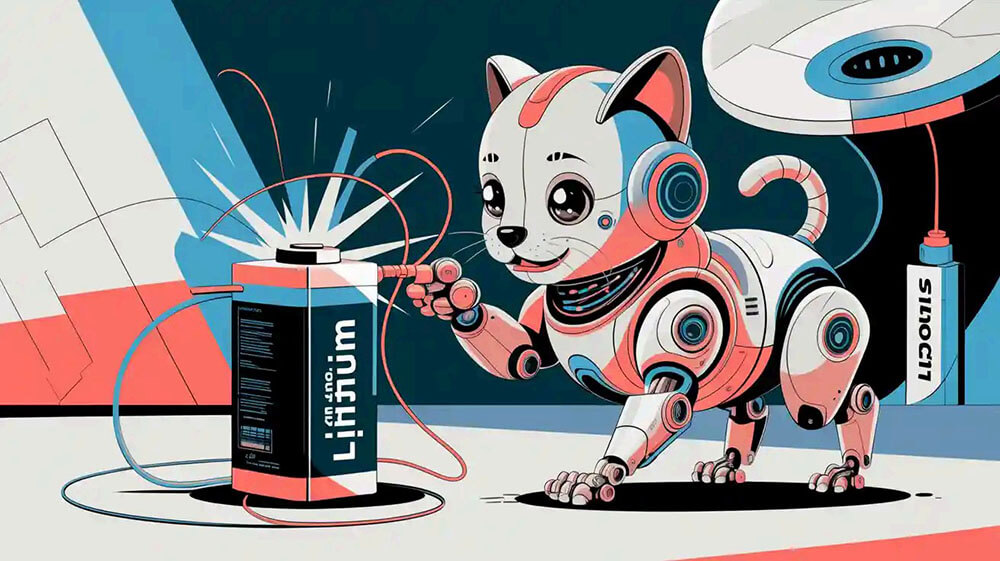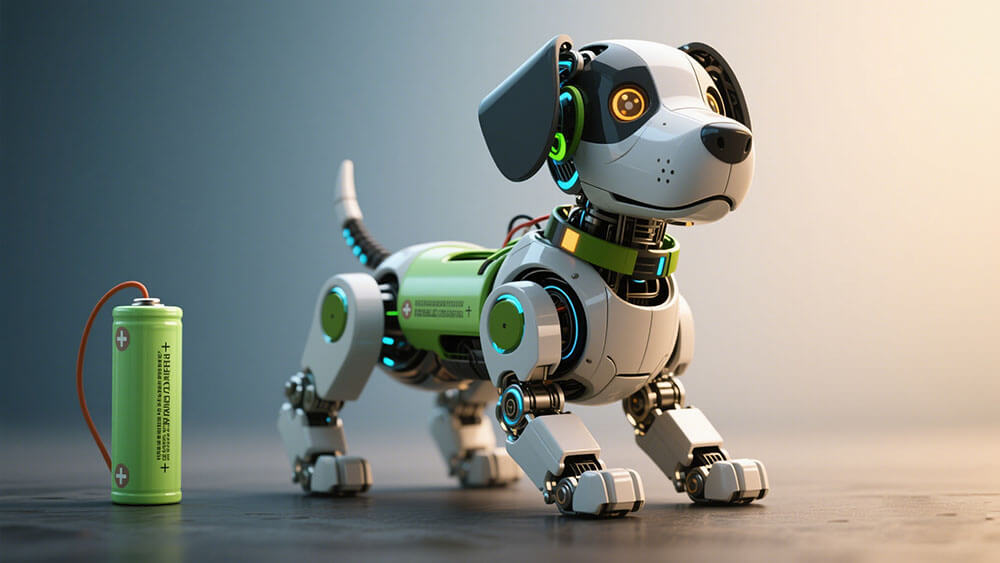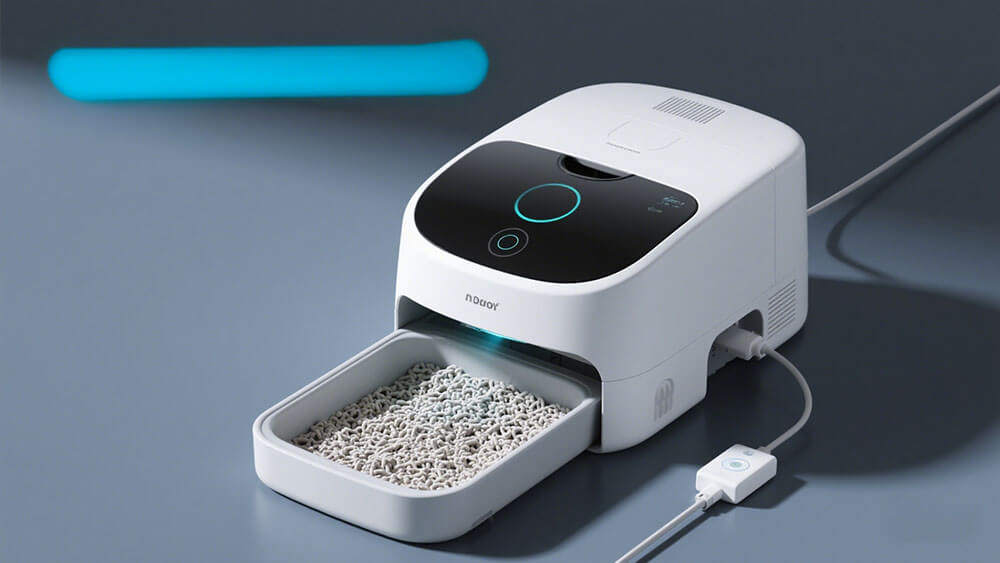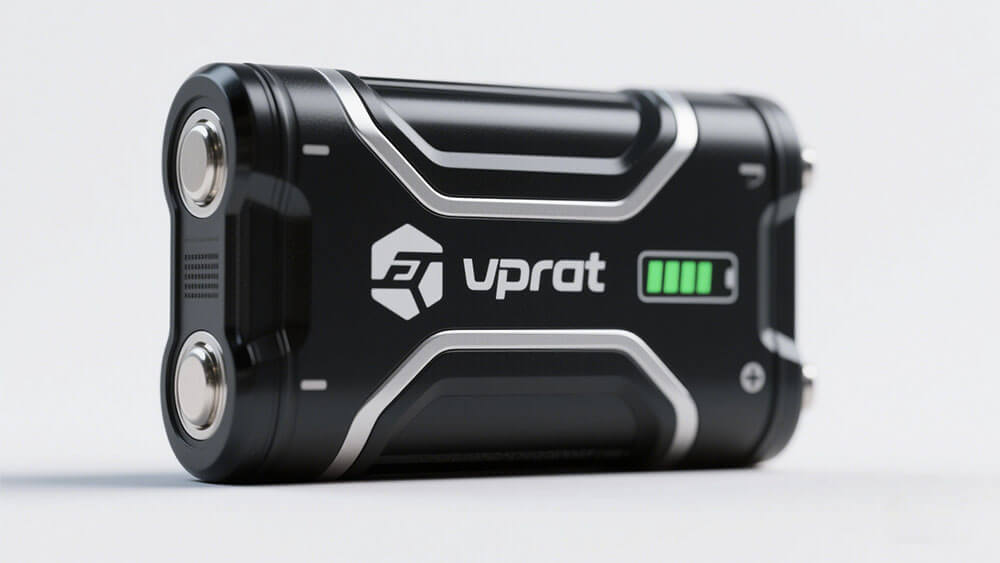Contents

Lithium batteries revolutionize the functionality of robotic pets by delivering unmatched energy density, lightweight construction, and rechargeability. Their versatility enables you to enjoy interactive experiences powered by advanced AI and responsive mobility. In 2024, lithium-ion batteries dominated 44.0% of the global battery market, showcasing their widespread adoption. As demand grows, technologies like the petbot of lithium battery continue to redefine this innovative space.
Key Takeaways
Lithium batteries store a lot of energy, helping robotic pets work longer. This lets them use smart features like AI and move quickly.
Lithium batteries are small and light, making robotic pets more agile. This design adds new features without making them bigger, boosting how well they work.
New battery types, like solid-state and lithium-metal, hold more energy and are safer. These new batteries will help robotic pets run longer and do more tasks.

Part 1: Types of Lithium Batteries in Robotic Pets
1.1 Lithium-Ion Batteries and Their Applications
Lithium-ion batteries have become the backbone of robotic pet technology due to their exceptional energy density and reliability. These batteries, Depending on the chemistry system, the nominal voltage is either 3.2 volts, or it falls between 3.6 and 3.7 volts and an energy density of 160–270Wh/kg, provide the power needed to support advanced features such as AI-driven decision-making and real-time mobility. Their long cycle life, ranging from 500 to 2,000 cycles, ensures durability, making them ideal for continuous operation in robotic pets.
You can find lithium-ion batteries in various robotic pet applications, from powering motors for movement to supporting sensors and processors for intelligent interaction. For instance, these batteries enable seamless integration of AI algorithms, allowing robotic pets to learn and adapt to user behavior. Their compact design also allows manufacturers to create sleek and lightweight robotic pets without compromising performance.
1.2 Lithium Polymer (LiPo) Batteries for Flexible Designs
Lithium Polymer (LiPo) batteries offer a unique advantage in robotic pet design due to their flexible and lightweight structure. Unlike traditional lithium-ion batteries, LiPo batteries use a polymer electrolyte, which allows for customizable shapes and sizes. This flexibility enables manufacturers to design robotic pets with intricate and compact forms, enhancing their aesthetic appeal and functionality.
LiPo batteries typically deliver an energy density of 150–200Wh/kg, making them suitable for applications requiring moderate power output. They are particularly effective in supporting advanced features like high-definition cameras and wireless connectivity modules. Additionally, their low weight contributes to improved mobility and agility in robotic pets, ensuring a more lifelike experience for users.
1.3 Emerging Battery Technologies for AI Robot Pets
The future of robotic pets lies in emerging battery technologies that promise higher energy densities and enhanced safety. Solid-State Batteries, for example, are gaining traction due to their ability to deliver energy densities of 300–500Wh/kg while minimizing the risk of thermal runaway. These batteries use a solid electrolyte, which not only improves safety but also extends the lifespan of robotic pets. Discover more about Solid-State Batteries here.
Another promising innovation is lithium-metal batteries, which also offer energy densities of 300–500Wh/kg. These batteries are ideal for powering advanced features like autonomous navigation and complex AI computations. As these technologies mature, they will enable robotic pets to operate for longer durations and perform more sophisticated tasks, redefining the boundaries of human-robot interaction.
Note: Sustainability remains a critical focus in battery development. Manufacturers are increasingly adopting conflict-free materials and eco-friendly production methods to align with global sustainability goals. Learn more about sustainability at Large Power.

Part 2: Advantages of Lithium Batteries in Robotic Pets
2.1 High Energy Density for AI and Mobility
Lithium batteries are renowned for their high energy density, a critical factor in powering robotic pets. With energy densities ranging from 160–270Wh/kg for lithium-ion batteries and up to 500Wh/kg for emerging technologies like solid-state batteries, these power sources ensure that your robots can operate efficiently for extended periods. This capability is essential for supporting advanced AI algorithms and mobility systems, which demand consistent and reliable energy.
For example, robotic pets equipped with lithium batteries can perform complex tasks such as real-time navigation and adaptive learning without frequent recharging. This efficiency stems from the batteries’ ability to convert up to 95% of the stored energy into usable power, minimizing energy loss during operation. Such performance not only enhances the functionality of robotic pets but also reduces operational costs over time.
2.2 Lightweight and Compact Design for Enhanced Performance
The lightweight nature of lithium batteries significantly contributes to the agility and mobility of robotic pets. These batteries are up to 70% lighter than traditional lead-acid alternatives, allowing manufacturers to design robots with sleek and compact forms. This reduction in weight directly translates to improved performance, as lighter robots can move faster and more fluidly.
Moreover, the compact design of lithium batteries enables the integration of additional features without increasing the overall size of the robot. For instance, you can incorporate high-definition cameras, advanced sensors, and wireless connectivity modules into your robotic pets, enhancing their interactivity and functionality. This adaptability makes lithium batteries an indispensable component in the development of next-generation robotic pets.
2.3 Long Lifespan and Fast Charging Capabilities
Lithium batteries excel in longevity and charging efficiency, two attributes that are crucial for robotic pet applications. Batteries with lithium iron phosphate (LiFePO4) cathodes, for instance, can endure over 5,000 charge cycles and maintain a lifespan exceeding 10 years. This durability ensures that your robotic pets remain operational for extended periods, reducing the need for frequent battery replacements.
Fast charging is another significant advantage. Lithium batteries can achieve full charge within 1–2 hours, a stark contrast to older technologies that require several hours. This rapid charging capability allows robotic pets to spend more time in operation and less time tethered to a charging station. For businesses, this translates to higher productivity and better user satisfaction.
2.4 Safety Mechanisms in Lithium Battery Packs
Safety is a paramount concern in the design of lithium battery packs for robotic pets. Modern lithium batteries incorporate advanced Battery Management Systems (BMS) to mitigate risks such as overheating, overcharging, and short circuits. These systems monitor and regulate the battery’s performance in real time, ensuring safe and reliable operation.
For robotic pets, these safety features are particularly important. They protect sensitive components like AI processors and mobility systems from potential damage caused by power fluctuations. Additionally, the use of non-flammable electrolytes in some lithium battery technologies further enhances safety, making them suitable for applications in both consumer and industrial environments.
Advantage | Description |
|---|---|
Energy Efficiency | Lithium batteries achieve up to 95% round-trip efficiency. |
Weight | They are up to 70% lighter than lead-acid alternatives. |
Charging Speed | Full charging can be completed in 1–2 hours. |
Safety Features | Advanced BMS prevents overheating, overcharging, and short circuits. |
Tip: To explore custom battery solutions tailored to your robotic pet designs, visit Large Power’s Custom Battery Solutions.

Part 3: Applications of Lithium Batteries in Robotic Pets
3.1 Powering Movement and Mobility in Robots
Lithium batteries play a pivotal role in enabling the movement and mobility of robotic pets. Their high energy density ensures consistent power delivery, allowing robots to perform dynamic actions such as walking, running, and even climbing stairs. The lightweight nature of lithium batteries further enhances mobility by reducing the overall weight of the robotic pet, enabling smoother and more agile movements.
Modern battery technologies also support efficient power management, ensuring that features like gesture recognition and chat functions operate seamlessly without rapid power depletion. Additionally, lithium batteries offer durability and reliability, maintaining performance across numerous charge cycles. This makes them ideal for robotic pets that require consistent energy delivery for extended periods. Rapid charging options, including wireless and Type-C charging, further enhance user convenience by minimizing downtime.
Feature | Description |
|---|---|
Efficient Power Management | Ensures smooth operation of features like chat functions and gesture recognition without quick power drain. |
Durability and Reliability | Withstands numerous charge cycles while maintaining performance, ideal for consistent energy delivery. |
Rapid Charging Options | Supports wireless and Type-C charging for quick recharges, enhancing user convenience. |
3.2 Supporting AI and Sensor Technologies
Lithium batteries provide the capacity needed to power advanced AI and sensor technologies in robotic pets. These components require a stable and reliable energy source to process data, execute algorithms, and interact with their environment. For example, AI-driven robotic pets rely on lithium batteries to perform real-time decision-making, adaptive learning, and voice recognition.
Sensors, such as proximity detectors and cameras, also depend on lithium batteries to function effectively. The high energy efficiency of these batteries ensures that sensors can operate continuously without frequent recharging. Emerging battery technologies, such as solid-state batteries, further enhance this capability by offering higher energy densities and improved safety. This allows robotic pets to deliver more sophisticated functionalities while maintaining operational efficiency.
3.3 Enabling Connectivity and Smart Features in Petbot of Lithium Battery
Lithium batteries enable the integration of connectivity and smart features in robotic pets, transforming them into intelligent companions. These batteries power wireless communication modules, such as Wi-Fi and Bluetooth, which facilitate seamless interaction between the robotic pet and external devices. This connectivity allows users to control their pets remotely, monitor their activities, and even update their software.
Smart features, including voice commands, facial recognition, and autonomous navigation, also rely on the capacity and fast charging capabilities of lithium batteries. For instance, a robotic pet equipped with solid-state batteries can perform complex tasks like mapping its surroundings or responding to voice prompts without interruptions. These advancements redefine the user experience, making robotic pets more interactive and engaging.
Tip: To explore custom battery solutions tailored to your robotic pet designs, visit Large Power’s Custom Battery Solutions.

Part 4: Challenges and Future Advancements in Battery Technologies
4.1 Current Limitations in Lithium Battery Systems
Lithium batteries have revolutionized robotic pet technology, but they still face challenges. For instance, lithium-ion batteries offer high energy density and reliability but are sensitive to temperature fluctuations and require advanced management systems. Lithium polymer batteries provide lightweight designs and high power output but have a shorter lifespan and demand careful handling. Lithium iron phosphate batteries excel in safety and long cycle life, yet their lower energy density limits operational time, reducing their high capacity for extended playtime.
Robotic pets often operate in diverse environments, which exposes batteries to extreme conditions. Current lithium batteries struggle with limited operational range and long charging times. These limitations can hinder the performance of advanced features like real-time AI processing and mobility. Addressing these challenges is critical to ensuring that robotic pets can deliver consistent and reliable functionality.
4.2 Innovations in Solid-State and Lithium-Metal Batteries
Emerging technologies like solid-state and lithium-metal batteries promise to overcome these limitations. Solid-state batteries, with energy densities of 300–500Wh/kg, offer improved safety and longer lifespans. Lithium-metal batteries push the boundaries further, delivering energy densities up to 560Wh/kg. These advancements enable robotic pets to store more energy, enhancing their features and extending operational time.
Manufacturer | Product | Wh/kg | Wh/L |
|---|---|---|---|
Solid Power | Silicon EV Cell | 390 | 930 |
Solid Power | Lithium Metal | 440 | 930 |
Solid Power | Conversion Reaction Cell | 560 | 785 |
QuantumScape | LiFePO4 (projected) | 230 | 600 |
QuantumScape | NMC (projected) | 300 | 1000 |

These innovations also improve charging efficiency, reducing downtime and ensuring that robotic pets remain operational for longer periods. As these technologies mature, they will redefine the storage capabilities of robotic pets, enabling them to perform more complex tasks with greater efficiency.
4.3 Sustainability and Conflict-Free Materials in Battery Production
Sustainability plays a vital role in the future of battery technologies. Manufacturers are increasingly adopting conflict-free materials and eco-friendly production methods to align with global environmental goals. For example, using recyclable materials in battery production reduces waste and minimizes the environmental impact. You can explore more about conflict-free materials in battery production here.
Additionally, advancements in battery recycling technologies ensure that valuable materials like lithium and cobalt are recovered and reused. This approach not only conserves resources but also reduces the dependency on mining. By prioritizing sustainability, the industry ensures that robotic pets remain an environmentally responsible choice for consumers and businesses alike.
Tip: If you’re looking for custom battery solutions that align with sustainability goals, visit Large Power’s Custom Battery Solutions.
Lithium batteries drive the evolution of robotic pets by enhancing interaction, battery life, and playtime. Their durability and reliability ensure consistent performance, while innovations in energy storage systems expand their applications. With advanced battery management systems, robotic pets deliver seamless functionality, redefining human-robot interaction across industries.
FAQ
1. What is the role of lithium batteries in AI robot pets?
Lithium batteries power AI robot pets by providing energy for movement, sensors, and AI functions. They ensure your pets remain active and responsive.
2. How does a 4400mAh lithium-ion battery benefit robotic pets?
A 4400mAh lithium-ion battery offers extended playtime for robotic pets. It supports continuous operation, allowing your pets to perform tasks without frequent recharging.
3. Why choose a petbot of lithium battery for your AI robot pets?
A petbot of lithium battery enhances AI robot pets with reliable power. It ensures seamless interaction and connectivity, making your pets more engaging and interactive.
Tip: For professional guidance on petbot of lithium battery, visit Large Power.





